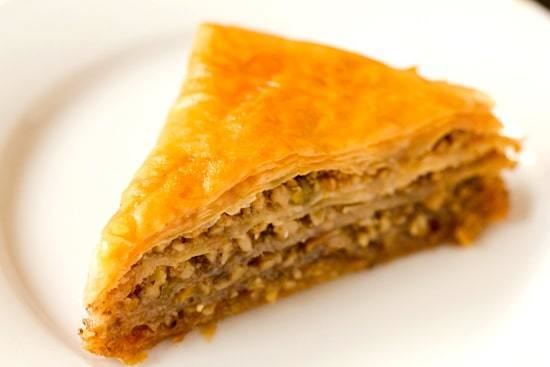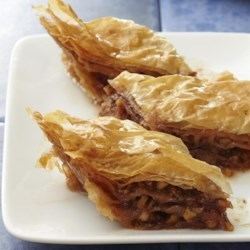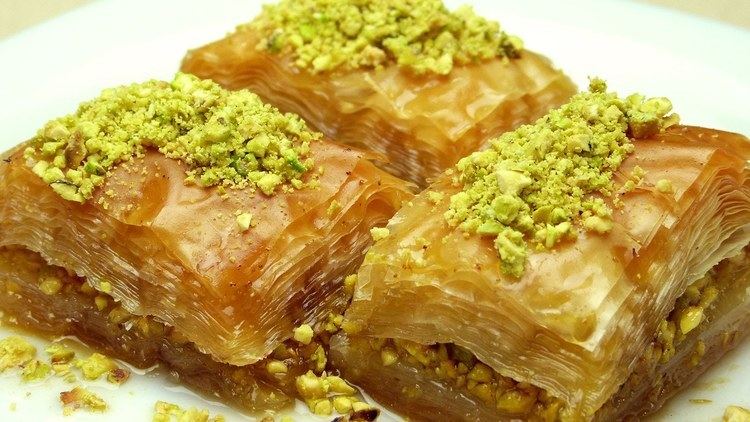Course Dessert Variations Multiple | Place of origin Ottoman Empire Origin Turkey | |
 | ||
Region or state Countries of the former Ottoman Empire, Middle East and Caucasus Serving temperature Cold, room temperature or re-warmed Main ingredients Filo dough, nuts, sweetening Similar Dessert, Kanafeh, Filo, Börek, Turkish delight | ||
How to make baklava easy turkish recipes
Baklava (/ˈbɑːkləvɑː/, /bɑːkləˈvɑː/, or /bəˈklɑːvə/; [bɑːklɑvɑː]) is a rich, sweet pastry made of layers of filo filled with chopped nuts and sweetened and held together with syrup or honey. It is characteristic of the cuisines of Levant, Mediterranean, Caucasus, Balkans, Maghreb, and Central and West Asia.
Contents
- How to make baklava easy turkish recipes
- Making baklava part 1 dough for baklava
- Name
- History
- Preparation
- Regional variations
- References

Making baklava part 1 dough for baklava
Name

The word baklava is first attested in English in 1650, a borrowing from Ottoman Turkish بقلاوه /bɑːklɑvɑː/. The name baklava is used in many languages with minor phonetic and spelling variations.

Buell argues that the word "baklava" may come from the Mongolian root baγla- 'to tie, wrap up, pile up' composed with the Turkic verbal ending -v; baγla- itself in Mongolian is a Turkic loanword. However, a possible Turkish origin is rejected by German Turkologist G. Doerfer. Another form of the word is also recorded in Persian, باقلبا (bāqlabā). Though the suffix -vā might suggest a Persian origin, the baqla- part does not appear to be Persian and remains of unknown origin.

The Arabic name بقلاوة baqlāwa is doubtless a borrowing from Turkish, though a folk etymology, unsupported by Wehr's dictionary, connects it to Arabic بقلة /baqlah/ 'bean'.
History

Although the history of baklava is not well documented, its current form was probably developed in the imperial kitchens of the Topkapı Palace in Istanbul. The Sultan presented trays of baklava to the Janissaries every 15th of the month of Ramadan in a ceremonial procession called the Baklava Alayı.
There are three proposals for the pre-Ottoman roots of baklava: the Central Asian Turkic tradition of layered breads, the Roman placenta cake, as developed through Byzantine cuisine, or the Persian lauzinaq.
The oldest (2nd century BCE) recipe that resembles a similar dessert is the honey covered baked layered-dough dessert placenta of Roman times, which Patrick Faas identifies as the origin of baklava: "The Greeks and the Turks still argue over which dishes were originally Greek and which Turkish. Baklava, for example, is claimed by both countries. Greek and Turkish cuisine both built upon the cookery of the Byzantine Empire, which was a continuation of the cooking of the Roman Empire. Roman cuisine had borrowed a great deal from the ancient Greeks, but placenta (and hence baklava) had a Latin, not a Greek, origin—please note that the conservative, anti-Greek Cato left us this recipe."
Shape the placenta as follows: place a single row of tracta along the whole length of the base dough. This is then covered with the mixture [cheese and honey] from the mortar. Place another row of tracta on top and go on doing so until all the cheese and honey have been used up. Finish with a layer of tracta. ... place the placenta in the oven and put a preheated lid on top of it ... When ready, honey is poured over the placenta.
Andrew Dalby identifies this, and surrounding dessert recipes in Cato, as coming from a "Greek tradition" and cites Antiphanes (fl. 3rd century BC) as quoted by Athenaeus. Some sources state that this Roman dessert continued to evolve during the Byzantine (Eastern Roman) Empire into modern baklava. In antiquity the Greek word plakous (Greek: πλακοῦς) was also used for Latin placenta, and the American scholar Speros Vryonis describes one type of plakous, koptoplakous (Byzantine Greek: κοπτοπλακοῦς), as a "Byzantine favorite" and "the same as the Turkish baklava", as do other writers. Indeed, the Roman word placenta (Greek: πλατσέντα) is used on the island of Lesbos in Greece to describe a baklava-type dessert of layered pastry leaves containing crushed nuts that is baked and then covered in honey.
Muhammad bin Hasan al-Baghdadi was a compiler from the Abbasid period who described lauzinaq, a dessert said by some to have been similar to baklava, though others say it was not like baklava. Lauzinaq, which derives from the Aramaic word for almond, refers to small pieces of almond paste wrapped in very thin pastry ("as thin as grasshoppers' wings") and drenched in syrup. Al-Baghdadi's cookbook, Kitab al-Tabikh, was written in 1226 (in today's Iraq) and was based on a collection of 9th century Persian-inspired recipes. According to Gil Marks, Middle Eastern pastry makers developed the process of layering the ingredients; he asserts that "some scholars said they were influenced by Mongols or Turks". The only original manuscript of al-Baghdadi's book survives at the Süleymaniye Library in Istanbul (Turkey) and according to Charles Perry, "for centuries, it had been the favorite cookbook of the Turks," though Perry also notes that the manuscript has no recipe for baklava. A further 260 recipes had been added to the original by Turkish compilers at an unknown date retitling it as Kitâbü’l-Vasfi’l-Et‘ime el-Mu‘tâde, and two of its known three copies can be found now at the Topkapı Palace Library in Istanbul. Eventually, Muhammad ibn Mahmud al-Shirwani, the physician of the Ottoman Sultan Murad II prepared a Turkish translation of the book, adding around 70 contemporary recipes.
Another recipe for a similar dessert is güllaç, a dessert found in the Turkish cuisine and considered by some as the origin of baklava. It consists of layers of filo dough that are put one by one in warmed up milk with sugar. It is served with walnut and fresh pomegranate and generally eaten during Ramadan. The first known documentation of güllaç is attested in a food and health manual, written in 1330 that documents Mongol foods called Yinshan Zhengyao (飮膳正要, Important Principles of Food and Drink), written by Hu Sihui, an ethnic Mongol court dietitian of the Yuan dynasty. Uzbek cuisine has pakhlava, puskal or yupka or in Tatar yoka, which are sweet and salty savories (börekler) prepared with 10–12 layers of dough.
There are also some similarities between baklava and the Ancient Greek desserts gastris (γάστρις), kopte sesamis (κοπτὴ σησαμίς), and kopton (κοπτόν) found in book XIV of the Deipnosophistae. However, the recipe there is for a filling of nuts and honey, with a top and bottom layer of honey and ground sesame similar to modern pasteli or halva, and no dough, certainly not a flaky dough.
Preparation
Baklava is normally prepared in large pans. Many layers of filo dough, separated with melted butter and vegetable oil, are laid in the pan. A layer of chopped nuts—typically walnuts or pistachios, but hazelnuts are also sometimes used—is placed on top, then more layers of filo. Most recipes have multiple layers of filo and nuts, though some have only top and bottom pastry.
Before baking (180 °C, 356 °F, 30 minutes), the dough is cut into regular pieces, often parallelograms (lozenge-shaped), triangles, diamonds or rectangles. After baking, a syrup, which may include honey, rosewater, or orange flower water is poured over the cooked baklava and allowed to soak in.
Baklava is usually served at room temperature, often garnished with ground nuts.
Regional variations
In Turkey, baklava is traditionally made by filling between the layers of dough with pistachios, walnuts, almonds (parts of the Aegean Region) or a special preparation called kaymak (not to be confused with kaymak, the creamy dairy product). In the Black Sea Region hazelnuts are commonly used as a filling for baklava. The city of Gaziantep in southeast Turkey is famous for its pistachio baklava and it regards itself as the native city for this dish, though it only appears to have been introduced to Gaziantep from Damascus in 1871. In 2008, the Turkish patent office registered a geographical indication for Antep Baklava, and in 2013, Antep Baklavası or Gaziantep Baklavası was registered as a Protected Geographical Indication by the European Commission. In many parts of Turkey, baklava is often topped with kaymak or, in the summer, ice cream (milk cream flavour, called kaymaklı dondurma).
In Greece, baklava is supposed to be made with 33 dough layers, referring to the years of Christ's life.
In Azerbaijan, Azerbaijani pakhlava is made with walnuts or almonds. It is usually cut in a rhombus shape. It is traditionally served during the spring holiday of Nowruz.
In Armenia, paklava is made with cinnamon and cloves.
In Iran, a drier version of baklava is cooked and presented in smaller diamond-shaped cuts flavored with rose water. The cities of Yazd and Qazvin are famous for their baklava, which is widely distributed in Iran. Persian baklava uses a combination of chopped almonds and pistachios spiced with cardamom and a rose water-scented syrup and is lighter than other Middle Eastern versions. Azerbaijani pakhlava is widely eaten in Iran, especially in Iranian Azerbaijan.
In Lebanon, Syria, Jordan, Iraq, Israel and Palestine, baklava is prepared from filo dough sheets, butter, walnuts and sugar syrup. It is cut into lozenge pieces.
In the Maghreb, mainly Libya, Tunisia, Algeria and Morocco, the pastry was brought along many others by the Ottomans, and is prepared differently depending on the regions and cities.
In Bosnia and Herzegovina cuisine the Ruzice is their variant of baklava.
In Crimean Tatar cuisine the pakhlava is their variant of baklava.
